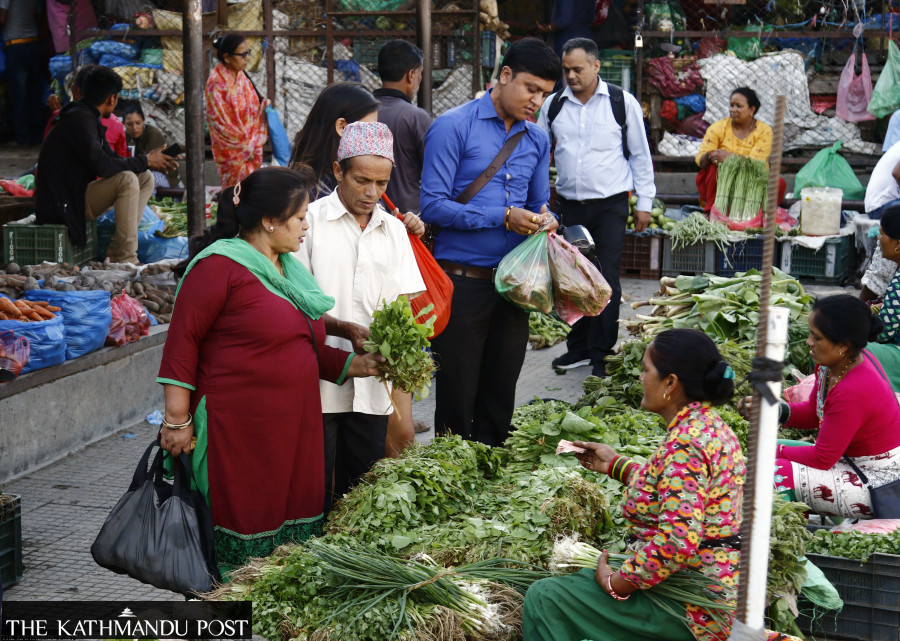
Post File Photo
Onion, tomato, cauliflower, bottle gourd, yard long beans, flat beans, round eggplant, potato, okra, capsicum, lentils.
The list of major kitchen staples that cost more than Rs100 per kg in the retail market is long.
Sabnam Shrestha, proprietor of New Road Ladies Tailor and Boutique, is worried about managing her finances this Tihar which begins on Wednesday.
Shrestha’s monthly kitchen expenses used to hover around Rs10,000 before the pandemic that hit Nepal in early 2020. Now it costs Rs20,000 per month to put food on the table.
“After the pandemic, we earned absolutely nothing for more than a year. There is no lockdown now, but my tailoring business has still not revived,” the 35-year-old resident of Chhetrapati told the Post. “Everything is expensive.”
Globally, freight charges have increased to their highest, and the jump in transportation costs has also been felt in Nepal. Along with record high imports, Nepal imported inflation too.
From January onwards, energy prices have been going up and up.
Petrol and diesel have become costlier by 21 and 25 percent respectively in the last 10 months. On January 18, petrol and diesel cost Rs110 and Rs93 per litre retail respectively. Nepal Oil Corporation has jacked up prices 14 times in the last 10 months. Currently, petrol and diesel cost Rs133 and Rs116 per litre respectively.
Nepalis staggering under economic stress have been hit with a steep rise in transport fares. The hike in transportation costs is the key driver of inflation.
Then on October 17, unusual rainfall started in the western part of Nepal and then moved to the eastern part on October 19, claiming lives and damaging roads and bridges and other physical infrastructure in various districts.
Fields filled with vegetables ready for harvest were inundated by the rain waters. The impact of the floods was promptly visible in the market.
“The price of edible oil has increased by more than Rs100 per litre while the price of split red lentils that cost Rs120-130 per kg has reached Rs160 per kg,” said Shrestha. “It’s really difficult to survive amid this price hike.”
Kitchen staples like onion and tomato now cost Rs95 and Rs130 per kg respectively.
The wholesale price of basic metals rose by 8.76 percent during the review period while electric and electronic products became costlier by 4.91 percent. The price of machinery and equipment swelled by 7.44 percent while the cost of transport, equipment and parts went up by 9.70 percent.
The wholesale price of construction materials increased by 12.03 percent. The steep rise in inflation has become a cause for concern.
Experts are worried that high inflation could make Nepali consumers cut back on their spending, which would be disastrous for the recovery.
Consumer spending is the main driver of Nepal's economy. The Central Bureau of Statistics has revealed that, in the last fiscal year 2020-21 that ended mid-July, Nepal’s final consumption expenditure at current prices amounted to Rs3.98 trillion, representing 93.38 percent of the gross domestic product.
“Obviously, the spike in inflation will negatively impact the economy. A rise in inflation means a decline in consumption, and people tend to invest less,” said economist Keshav Acharya.
When consumers start to hold back on their consumption budgets, it will adversely affect the production cycle, which cuts employment and reduces government revenue.
“The reduced output, ultimately, will hit the GDP or economic growth,” said Acharya. “But imports will drop, which, in fact, is not bad for our economy.”
Acharya said, “Inflation has two side effects. It will affect income and push consumers to look for alternatives. This is the substitution effect. The substitution effect is a decrease in sales for a product that can be attributed to consumers switching to cheaper alternatives.”
Prices of food, non-food and services have all been rising continuously in recent months. But these figures are not reflected in Nepal’s central bank’s macroeconomic statistics.
Nepal's macroeconomic statistics show that consumer price inflation has dropped below India’s inflation. Inflation in India was 4.35 percent in mid-September while in Nepal it was 3.49 percent.
According to Nepal Rastra Bank, the year-on-year consumer price inflation stood at 3.49 percent in the second month of the fiscal year 2021-22 (mid-August to mid-September) as compared to 4.52 percent previously.
“Observing the global phenomenon, Nepal is no exception to inflation pressure. It will, however, remain for a certain time,” said Gunakar Bhatta, executive director of Nepal Rastra Bank.
“The world is facing a supply shortage. The price of petroleum products has been increasing. Freight charges have increased to their highest level. There is a shortage of transportation vehicles and human resources in different sectors. All this has a combined effect on supply shortage, which eventually increases product prices.”
The price of edible oil has been increasing in South Asian countries. Semiconductor chips are in short supply that is making electronic gadgets expensive.
As per the National Consumer Price Index report of the central bank, the price of ghee and oil increased by 28.91 percent in mid-September as compared to the same period in the last fiscal year.
The price of meat and fish rose by 10.66 percent, pulses and legumes by 8.67 percent and sugar and sugar products by 3.11 percent during the review period.
The price of non-alcoholic drinks increased by 10.25 percent while alcoholic drinks and tobacco products became costlier by 7.49 and 9.99 percent respectively.
The price of non-food and services also increased in the review period with costs swelling by 9.92 percent in transportation, 3.41 percent in clothes and footwear, 4.30 percent in health, 2.61 percent in communication and by 3.89 percent in education.
State-owned oil monopoly Nepal Oil Corporation on Friday increased the price of petrol and diesel by Rs3 per litre in its 14th price hike in the last 10 months.
“Inflation is unpredictable now. There are multiple factors impacting inflation. We cannot say when it will decline,” said Bhatta.
According to Bhatta, Nepal’s paddy production this year has been battered by the unseasonal October rainfall, which might impact food prices further.
In its revised estimate of losses, the Ministry of Agriculture and Livestock Development said that the unusual rainfall had caused losses amounting to Rs11.87 billion. The ministry said that an estimated 424,113 tonnes of paddy on 111,609 hectares had been destroyed.
The latest statistics show that 90,996 hectares of paddy has been destroyed. Similarly, 62,155 hectares of paddy has been partially damaged and 39,383 hectares of paddy slightly damaged.
Inflation has become a headache globally due to the supply shortage. Inflation in the United States in September was the highest since July 2008. The current inflation in Germany is the highest in three decades.
Consumer rights activist Prem Lal Maharjan charged that the government's failure to monitor the market properly had fueled inflation.
Maharjan, president of the National Consumer Forum, said that the government was least interested in checking the market.
“Opportunist traders are taking undue advantage of the political instability,” he said. “Prices are rising and they will keep on rising.”













